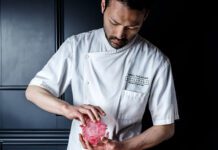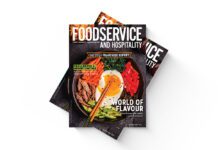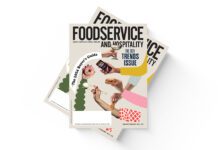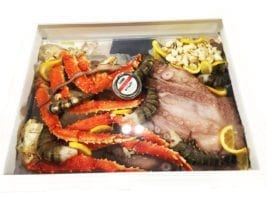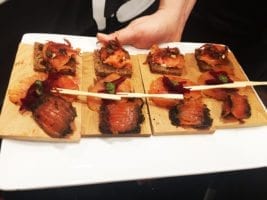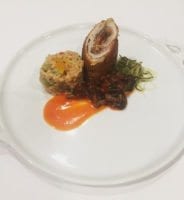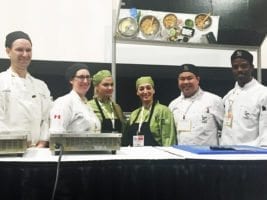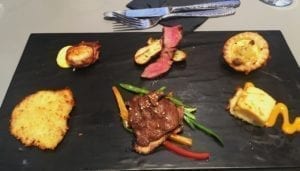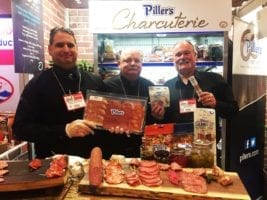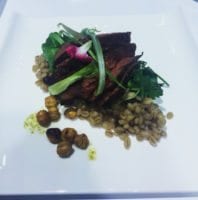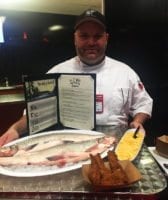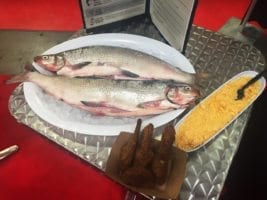Restaurants Canada’s annual RC Show once again brought Canada’s foodservice industry together for three days of networking and learning. This year’s event, which took place at the Enercare Centre in Toronto, focused on the theme “Canada Unleashed”, in celebration of Canada’s 150th anniversary.
Meat is Still King
Another trend very apparent at this year’s Restaurants Canada Show Today’s was diners’ desire to know more about the food they eat — how it was raised, slaughtered and processed are big concerns. F&H spoke to Tanya Thompson, national account manager – Canada for Cargill Foodservice about how the company is addressing this growing demand for transparency.
“Cargill does not produce or raise cattle, so we remind consumers that cattle are typically raised on family owned ranches,” said Thompson. “Canadian ranchers do a wonderful job raising animals with care and are excellent environmental stewards because they know the importance of preserving resources and a healthy environment for future generations. Theranchers’ livelihoods depends on healthy cattle and a healthy environment in which to raise them.”
Once the cattle arrive at Cargill’s beef-processing facilities, she said animal handling areas are under 24/7 video monitoring by a third party for animal welfare purposes. “Our handling areas were designed in collaboration with Dr. Temple Grandin, a world-renowned animal-welfare specialist. Calm cattle also result in more tender meat, so it is not only in the best interest of the animals, but it is also good business to treat cattle well. Additionally, at our largest Canadian beef-processing facility in High River, Alta., we have been a leader in environmental stewardship. We capture methane gas generated from our water-treatment lagoons and use it as fuel to heat boilers with water used for food safety and plant-sanitation purposes. This prevents methane, a greenhouse gas, from escaping into the atmosphere, and reduces our needs for fossil fuels.”
A few years ago, Cargill worked with the provincial government on an innovative effort to convert waste to energy at High River, installing specialized equipment that uses organic waste from the plant as a fuel source to generate electricity, “further reducing our use of fossil-fuel-produced electricity and reducing waste going to landfills.” When discharged, treated water from the plant goes to nearby Frank Lake, which is a wetlands habitat for migratory and indigenous birds. “Recently, we also worked with a major quick-service restaurant customer in Canada on a successful traceability pilot project whereby cattle were traced from birth to burger. We believe this could be the model for traceability that would provide consumers with the type of information they may want to know about where their beef comes from.”
As consumers become more educated about healthy eating, food choices are tending more towards plant-based dining. So how will meat fare in this new foodservice environment? “Actually, we see meat protein robustly trending in a positive direction,” said Thompson. “Recent consumer research tells us at least 95 per cent of the population continues to enjoy eating meat products. We are certainly monitoring closely the trends in meat alternatives, including plant-based protein.”
Cargill’s protein business is looking at all forms of protein – animal, plant, insect and others as it moves forward. “We believe there is a place for these products because we believe in consumer choice,” she explained. “While beef is sometimes thought of as an indulgence due to its price compared with other proteins, consumers are often willing to pay a higher price for a great eating experience. Guests dining out usually do not seek the cheapest steak around — they seek out the best and once they find it, they tell their friends and restaurant growth and increased profitability usually follow.”
With meat prices on the rise, Thompson said many restaurants are looking to less traditional cuts such as flat irons, navels (beef belly) and bones. “The Cargill beef navel was actually used as the main dish at the Restaurants Canada gala dinner at Casa Loma,” she said. “I think cost is a factor, but there is also a desire to explore nose-to-tail protein for new and unique dishes for guests.”
Around the Show
During the show, more than 80 events were hosted on the conference’s seven stages. Here is a sampling of the seminars featured:
Emerging trends in tea: Louise Roberge, president of the Tea and Herbal Association of Canada (formerly Tea Association of Canada), highlighted ways operators could drive tea sales in today’s evolving market. She noted that the way tea is presented on menus, especially in full-service restaurants, has a big impact on customers’ willingness to buy. “How can you expect to sell pie when you just say “pie” [on your menu]?” Roberge asked, noting the disparity in how coffee and tea are described on menus. “As soon as you give them some qualification on the tea…you can put more dollars to it,” she added.
With diversifying taste and increased interest in tea, Roberge characterized tea as an offering that is often overlooked. “As the population is diversifying, we are also diversifying our taste,” she explains. “Millennials are embracing a lot of beverages and they’re embracing tea, but don’t forget the boomers.” Roberge notes that because many from this group will be retiring soon, they will have more time to prepare and enjoy tea.
Marketing your brand through storytelling: Arlene Stein, executive director & founder of Terroir Hospitality, spoke to the power of branding and how to shape your establishment/brand’s unique identity through storytelling. During her discussion, Stein pointed to brands such as Rive Select as examples of those that are effectively telling the story of their history and philosophy through logos and online presence. “When we tell our stories or share our stories, we impassion people to enjoy, appreciate and like what we do,” she explained. “So, we’re creating an emotional attachment.”
Stein said it is key to link the logo/image associated with a product with the story behind it. By conveying part of this story through imagery, brands can inspire curiosity and interest in the origins of the product and support the creation of a community of people that aligns with their philosophies. “The interesting thing about any food stories, is that they inspire you to go and actually see the place where it came from, the people that created it, the culture surrounding it,” she added.
Experience something new: In a seminar presented by tasteUS, chef Sang Kim demonstrated how traditional ethnic dishes, such as Korean cuisine, can be reimagined using North American products. To demonstrate this point, Kim created kkakdugi — a traditional radish-based kimchi — using Bosc pears from Oregon.
Kim noted the key to successful substitutions, such as using California-grown rice rather than the traditional Japanese sushi rice, relies on properly understanding the ingredient’s unique qualities. As he explains, the California-grown grain requires a longer rinse time, as well as a longer resting period.
The 2017 RC Show was also the site of several competitions, including the Frankie Tomatto’s Restaurant Innovation Award, “Iron Chef” culinary student competition and a series of bartender competitions.
Danielle Schalk
Piller’s Now Has Chacuterie Packs!
Blended Family
Vitamix showcases Aerating Container and Vitamix XL machine
Clean Sweep
Ecolab introduces new DuraLoc Floor Cleaning Tools
Multi-Tasking
RATIONAL’s latest innovation — the SelfCookingCenter — was put through its paces at the show, grilling, roasting, baking, steaming, stewing, blanching and poaching — all within a space of less than 1 m² (11 ft²). Check out our interview with the company’s corporate chef.
Cooking with Ontario Turkey
The Rhyming Chef
High Liner Culinary serves up sizzling seafood
Instant Satisfaction
Just Drink It
Sweet Beginnings
Parmalat previews fresh yogurt dispenser
SBS Solutions debuts MAVAM Espresso Machine

A Shot of Delicious
The Under-Counter from MAVAM espresso machines answers the need for a low profile, temperature stable espresso machine that still has a traditional identifiable look.







